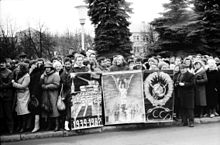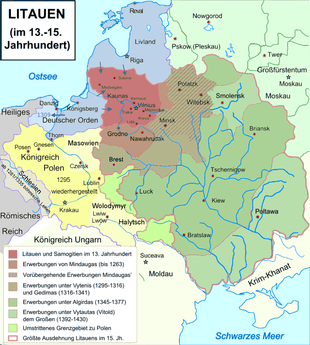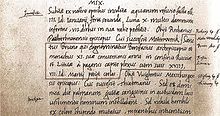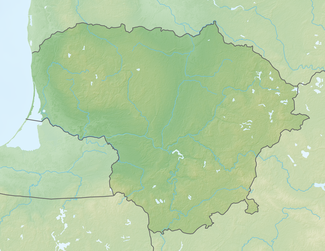Lithuania
![]()
This article is about the state in the Baltic States (1918-1940 and from 1990). For other meanings, see Lithuania (disambiguation).
Template:Infobox State/Maintenance/NAME-German
Lithuania [ˈliːta͜uən; ˈlɪta͜uən] (Lithuanian Lietuva, officially Republic of Lithuania, Lithuanian Lietuvos Respublika) is the southernmost of the three Baltic states. It borders the Baltic Sea to the west and shares borders with Latvia, Belarus, Poland and Russia (exclave Oblast Kaliningrad).
In the years from about 1253 to 1795 Lithuania was a Grand Duchy, from 1569 part of a union as Poland-Lithuania. With the 3rd partition of Poland, Lithuania was absorbed into Russia in 1795, until it became a sovereign republic in 1918 in the act of Lithuania's declaration of independence. After Soviet occupation (1940), interrupted by German occupation (1941-1944), it regained independence in 1990. Following EU enlargement in 2004, Lithuania became a member state of the European Union and a member of NATO. Since 1 January 2015, Lithuania is the 19th member of the Eurozone.
Lithuania has 3 million inhabitants (as of 2021). The capital and largest city of Lithuania is Vilnius (588,412 inhabitants). Other major cities are Kaunas (315,000), Klaipėda (166,861) and Šiauliai (111,967). Panevėžys is the fifth largest city with 92,944 inhabitants.
Geography
|
|
Lithuania is located in the south of the Baltic States. The classification of the region as a whole, in turn, is controversial and is influenced not only by geographical factors but also by historical-cultural and political aspects. Thus, the Baltic States are assigned to Northern Europe, Central Europe (East-Central Europe), Eastern Europe and Northeastern Europe.
Lithuania borders Latvia to the north and Belarus to the east and southeast. The border with Poland in the south is only about 100 kilometres long; it is considered the most important connection to Central and Western Europe. To the southwest, the Russian oblast of Kaliningrad is an exclave; the border is partly formed by the Memel River. To the west lies the Baltic Sea, to which Lithuania has access via the port of Klaipėda.
Geographers from the Institut Géographique National, France's national geography institute, calculated the geographical centre of Europe in 1989 and identified a location in the village of Purnuškės just north of Vilnius.
Geology
Lithuania lies within the Eastern European Platform and has therefore been relatively tectonically quiet for a long time. The surface was decisively shaped by the repeated advances of the inland ice during the Ice Age. Therefore, only very few older rocks are found on the surface. In terms of landscape, almost all of Lithuania belongs to the young moraine country, which was covered by the ice of the last, the Weichselian ice age. 20,000 years ago, at the peak of the Vistula glaciation, only a small strip in the extreme southeast remained ice-free.
In the west, the country borders the Baltic Sea with sandy beaches. The Lower Lithuanian Land Ridge in the western part of Lithuania belongs to the Baltic Land Ridge. The hill country in the southeast belongs to the Belarusian Ridge. Here lie the highest elevations in Lithuania (294 m) (Aukštasis kalnas and Juozapinės kalnas). The largest rivers are the Memel and Neris, both of which have their source in Belarus. In the northeast is the lake district of Hochlitauen. There are also numerous lakes in the south. In total, lakes occupy about 1.5% of the country's area. Part of the Curonian Lagoon and the Curonian Spit also belong to Lithuania.
The largest part of the country's area is occupied by agricultural land. Just over 30% of the area is covered by forests and over 3% by peatlands and swamps. The area of Lithuania consists of 62,680 km² of land and 2,620 km² of water.
Climate
| Kaunas | ||||||||||||||||||||||||||||||||||||||||||||||||
| Climate diagram | ||||||||||||||||||||||||||||||||||||||||||||||||
| ||||||||||||||||||||||||||||||||||||||||||||||||
| Monthly average temperatures and precipitation for Kaunas
Source: Lithuanian Hydrometeorological Service | ||||||||||||||||||||||||||||||||||||||||||||||||||||||||||||||||||||||||||||||||||||||||||||||||||||||||||||||||||||||||||||||||||||||||||||||||||||||||||||||||||||||||||||||||||||||||||||||||
The climate in Lithuania is a temperate continental climate. The prevailing westerly wind on the coast carries warm and humid air from the Baltic Sea inland.
The warmest month is July with an average of 17 °C, the coldest month is January with an average of -5.1 °C. The average annual temperature is 6.2 °C. The average annual precipitation is 661 mm, significantly higher in the southwest and lower in the north.
Environment
There are over 200 nature reserves of various designation and rank in Lithuania. These include five national parks, seven protected areas under the Ramsar Convention, four total reserves and thirty regional parks. Over 14% of the country's territory is occupied by nature reserves, such as the Praviršulio tyrelis area. A very well-known raised bog among bog explorers is the Aukštumala bog between Sowetsk and Klaipėda, as it was the first bog in the world to have a special monograph dedicated to it (C. A. Weber, 1902). While the western part is still very well preserved, in the eastern part large-scale peat extraction is carried out by a subsidiary of the German concern Klassmann-Deilmann. The raised bog is part of the Memel Delta Regional Park. Upper Lithuania (Aukštaitija) is partly very hilly and rich in lakes, in the centre of this area lies the Aukštaitija National Park.

Topography of Lithuania
History
→ Main article: History of Lithuania and Lithuanian Wars of the Teutonic Order
Baltic tribes settled the area from the 3rd millennium BC. The beginning of Lithuania as a state lies in the 13th century. Prince Mindaugas, who even had himself crowned king in 1253 with the Pope's approval, brought the neighbouring tribes under his sovereignty by military force. At his death in 1263, his principality/kingdom covered approximately the area of today's Lithuania. The formation of the state took place just in time to be able to successfully resist the knights of the Teutonic Order advancing from the north and south.
Parallel to this, the expansion to the east already took place in the 14th century. From the disintegration of the old Kievan Rus after the Mongol storm until 1240, several successor principalities had developed. The Teutonic Order prevented Lithuania from pursuing an expansive western policy, while the eastern flank lay open due to the Tatar invasion. The Grand Duchy of Lithuania advanced into this power vacuum and, with the conquest of Kiev (after 1362), found itself in competition with the Grand Duchy of Moscow for supremacy among the Russian constituent principalities. Lithuanian eastward expansion reached its peak in the first half of the 15th century.
Grand Prince Jogaila assumed the Polish royal crown in 1386 through marriage and conversion to Christianity (after Mindaugas' death in 1263, Lithuania had "become" pagan again), thus establishing the Polish-Lithuanian Personal Union. Jogaila (Polish: Jagiello) founded the ruling dynasty of the Jagiellons. After the victorious Battle of Tannenberg in 1410, the threat of the Teutonic Order was finally eliminated. This battle had been won by a united Polish-Lithuanian army.
The close political union of Poland and Lithuania resulted in the Real Union of Lublin in 1569, which meant the end of independent Lithuania, after the Lithuanian nobility had already increasingly come under the influence of Polish culture and language in the preceding decades. Thus, in the times of the Reformation, Lithuania went the Polish way and remained Catholic, while the northern, German-influenced Baltic became Protestant. Lithuania remained with the Polish state until the partitions of Poland, and then came under Russian rule in 1795. Two Polish-Lithuanian uprisings in 1831 and 1863 were bloodily suppressed by the Russian Tsar.
Lithuania in World War I: On August 18, 1915, during the summer offensive, the city of Kaunas was captured by the Germans. This was followed by the German occupation of Lithuania. The territory was subordinated to the Commander-in-Chief East. The head of the Lithuanian administration became Prince Franz Joseph of Isenburg. First located in Tilsit, this administration was transferred to Kaunas in April 1916 and to Vilnius in March 1917.
Independence
The end of the First World War with the October Revolution and the subsequent civil war led in February 1918 - still under German occupation - to the proclamation of the independent Republic of Lithuania, which was also enforced after battles against the Red Army and Polish troops. However, the capital at this time was not the historic Grand Duchy seat of Vilnius, but Kaunas, since the Vilnius region was occupied by Poland (1920 to 1939, recognized by the League of Nations in 1923). Parliamentary democracy, introduced by the 1922 constitution, was eliminated by Antanas Smetona's coup in December 1926; Smetona subsequently ruled dictatorially until 1940. New constitutions were introduced that confirmed Smetona's authoritarian leadership, including the Lithuanian Constitution of 1928 and that of 1938. After a German ultimatum, Lithuania was forced to cede the Memelland to Germany on 23 March 1939. The Memelland had belonged to the German Empire until 1919, had been disputed between Germany and Lithuania ever since, and had therefore been under French League of Nations administration since the Versailles Peace Treaty. It had been occupied by Lithuanian irregulars on 10 January 1923 and subsequently annexed by Lithuania.
Second World War
With the outbreak of World War II, pressure from the Soviet Union intensified. Smetona abdicated in June 1940, and after the invasion of Soviet troops, a pro-Soviet government was brought into office, which declared accession to the Soviet Union (August 3, 1940). After the start of the German-Soviet War, German troops captured Lithuanian territory until July 1941. Einsatzgruppen (task forces) of the Security Police and the SD with Lithuanian auxiliaries and so-called Schutzmannschaften subsequently murdered a large part of the Jewish population until December 1941, and the survivors were concentrated in ghettos. 90% of the country's Jewish population did not live to see the end of the war.
In the course of its summer offensive in 1944, the Red Army again occupied large parts of Lithuania. The Lithuanian Soviet Socialist Republic (LSSR) was re-established. The resistance of the so-called "Forest Brothers" against the Soviet occupation was doomed without foreign support and had dwindled to a few partisan associations by 1948. Stalin had tens of thousands of "anti-state elements" deported to Siberia in 1949 in a third major wave of deportations, after arrests and deportations had already been carried out on a large scale in 1940/41 and 1945/46. Many of the deportees died in the penal camps in the east of the Soviet Union. The deportees also included German "wolf children" who had fled from the Königsberg region to Lithuania in the course of the turmoil of war to escape starvation and had often found shelter with farmers.
By the end of the Second World War, some 65,000 Lithuanians had fled to Germany as war refugees.
regaining of independence
In the wake of perestroika, which triggered the Singing Revolution in the Baltic States, Lithuania became the first Union republic of the Soviet Union to declare itself a sovereign state in 1990 and renamed the Supreme Soviet the Constituent Assembly. Iceland was the first state to recognize independent Lithuania, also in 1990. In the January events in Lithuania on January 13, 1991, pro-Soviet military forces unsuccessfully attempted to overthrow the fledgling democracy with tanks; 14 youthful demonstrators died at the television tower. In response, Lithuanians declared their "yes" to the country's independence in a referendum on February 8, 1991. With a turnout of 84.7%, 90.5% voted in favour of independence. After the failed Moscow coup against Gorbachev in August 1991, the countries of the West recognized the independence of Lithuania, as well as of the neighboring countries Latvia and Estonia. After an initial economic crisis and political instability due to radical privatization, reform policies gained momentum, especially after the Russian crisis was overcome in 2000.
Lithuania became a member of the EU and NATO in 2004. Since 21 December 2007 Lithuania is part of the Schengen area.

Lithuanians at the Gorbachev meeting in Šiauliai

Lithuania's expansion to the southeast under the Grand Dukes Mindaugas I. Vytenis, Algirdas and Vytautas - territorial development during the late Middle Ages

First mention of Lithuania as "Litua" in 1009 in Quedlinburg annals
Questions and Answers
Q: What is the area of Lithuania?
A: The country's area is 65,300 km².
Q: How many people live in Lithuania?
A: There are about 2.8 million people who live in Lithuania.
Q: What language is spoken in Lithuania?
A: The national language is the Lithuanian language, which is spoken by around 3 million people.
Q: What city is the capital of Lithuania?
A: Vilnius is the capital and largest city.
Q: Is Lithuania a member of any international organizations?
A: Yes, Lithuania is a member of the European Union, NATO, and several other organizations.
Q: What colors are on the Lithuanian flag? A: The colors of the Lithuanian flag are yellow (at the top), for the sun, green (in the middle), for the fields, and red (at the bottom), for the blood of Lithuanians fighting for its independence.
Search within the encyclopedia
